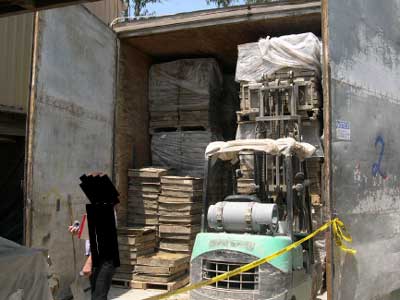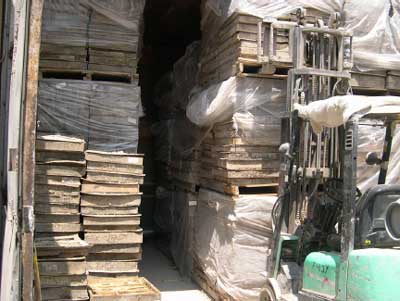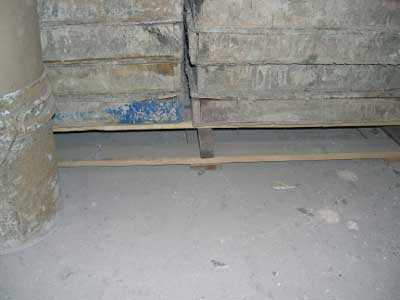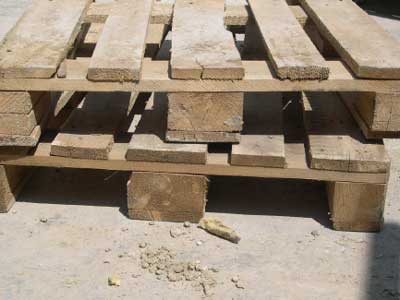A 17-year-old Hispanic Laborer Died when Crushed by Concrete and Stone Castings.
California Case Report: 05CA005
Summary
A 17-year-old Hispanic laborer died when he was crushed by stacked pallets of stone and concrete castings that were being cured in an oven. The victim was guiding a forklift with a pallet of concrete and stone castings into place when other stacked pallets collapsed on him. The victim was unable to get out of the way in time. The pallets being used were not strong enough to carry the weight of the castings being stacked for curing. The victim was originally reported as being 21-year-old worker, but when the death certificate was obtained, it listed his correct age. The CA/FACE investigator determined that, in order to prevent future occurrences employers, as part of their Injury and Illness Prevention Program (IIPP), should:
- Ensure employees use pallets that will support the weight of the castings being stored.
- Ensure employees are trained in safe work practices, and that their achievements of skills are verified through a testing program.
In addition, employers should:
- Establish work policies that comply with employment standards for youth less than 18 years of age in nonagricultural occupations.
Introduction
On May 2, 2005, at approximately 4 p.m., a 17-year-old Hispanic laborer died when concrete and stone castings that were stacked on pallets in a curing oven collapsed and crushed him. The CA/FACE investigator learned of this incident on May 12, 2005, through the Legal Unit of the Division of Occupational Safety and Health (Cal/OSHA). Contact with the victim’s employer was made on May 19, 2005. On May 26, 2005, the CA/FACE investigator traveled to the office of the insurance carrier that represented the company, and interviewed the risk management specialists who had conducted an investigation of the incident. The risk manager of the company was also contacted and assisted with pertinent information regarding this incident. The company administration requested that other employees involved in the incident not be interviewed again because the administrators “did not want them to re-experience the incident.” The employer of the victim was a manufacturer of stone and concrete products. The company had been in business for over 50 years and had 250 employees. The victim had been employed with the company for one month when the incident occurred. The victim was born in Mexico and had been in the United States for less than a year. The victim presented identification to the company that stated he was 21 years old. The victim did not speak English and had needed an interpreter to fill out his work application.
The company had a written safety program that was printed in English and had some parts printed in Spanish. The program had generic procedures that were not task-specific for employees to follow. Safety meetings were held monthly and were documented. The company had a training program that consisted of on-the-job training. Training was measured by supervisor observation. The victim was hired to perform general labor, and there was no task-specific training given to him.
Investigation
The site of the incident was a curing oven located at a manufacturing plant that made concrete and stone products. On the day of the incident, the victim was helping forklift operator place a pallet of newly formed concrete and stone castings into a curing oven (Exhibit 1). The victim was acting as the eyes for the forklift operator because the load was obstructing the forklift operator’s view. The victim was standing in front of the forklift and near stacked pallets in the curing oven as he guided the forklift operator with a load of palletized concrete and stone castings into place. Without warning, the stacked pallets within the curing oven collapsed. The victim was unable to get out of the way and was crushed by the falling material. Several employees responded to help rescue the victim. The paramedics were called, and they treated the victim then transported him to a local hospital where he died from his injuries. The pallets that were used in the curing oven were of construction and design that were not compatible with the weight of the material being stored on it.
Cause of Death
The cause of death, according to the death certificate, was blunt force head injuries.
Recommendations/Discussion
Recommendation #1: Ensure employees use the proper pallets to support the weight of the material being stored.
Discussion: The material being stored in this case was heavy. When materials are stored on pallets, and then stacked on top of one another, the pallet must be designed to hold the weight of the material. In this case, some of the pallets being used were not of the proper design and construction to support all the weight of the concrete and stone castings. Had heavier constructed pallets been used to stack and store the concrete and stone castings, this incident might have been prevented.
Recommendation #2: Ensure employees are trained in safe work practices, and that their achievement of skills are verified through a testing program.
Discussion: All new employees need to be made aware of all the potential hazards and danger areas associated with their jobs, even when they are hired as a laborer. It is important to test all employees on their understanding of these safety factors, especially those who do not speak English, to determine their level of understanding. Had the victim been made aware to look for this type of unsafe environment, this incident might have been prevented. Employers can enhance worker compliance with safe work practices through programs of task-specific training, supervision, recognition, and progressive disciplinary measures.
Recommendation #3: Employers should establish work policies that comply with employment standards for youth less than 18 years of age in nonagricultural occupations.
Discussion: At the time the victim was hired, he presented authentic-appearing social security and alien residence cards, both of which were forged. For this reason, it may have been difficult for the employer to ascertain the victim’s correct age. However, employers should make every effort to ensure they are aware of a worker’s true age and that 17-year-old workers are not assigned to perform prohibited work. Employers who have a multilingual/multicultural work force should use interpreters when necessary to inform all employees about age-appropriate work assignments. If employers do not fully understand the types of work prohibited for young workers, they should contact the U.S. Department of Labor (DOL), Employment Standards Administration (ESA), Wage and Hour Division. This Division enforces child labor laws under the Fair Labor Standards Act (FLSA). Employers should communicate these work policies to all employees.
References
- California Code of Regulations, Vol. 9, Title 8, Sections 3273, 3338, 1549
- https://www.cdc.gov/niosh/face/In-house/full200307.html
- https://www.cdc.gov/niosh/face/stateface/wa/98wa113.html
- https://www.cdc.gov/niosh/2001-109.html
- https://www.cdc.gov/niosh/docs/95-125/ (Link Updated 4/8/2015)
- https://www.cdc.gov/niosh/face/In-house/full200408.html
- https://www.cdc.gov/niosh/face/In-house/full200505.html
Exhibits
California Fatality Assessment and Control Evaluation (FACE) Project
The California Department of Health Services, in cooperation with the Public Health Institute and the National Institute for Occupational Safety and Health (NIOSH), conducts investigations of work-related fatalities. The goal of this program, known as the California Fatality Assessment and Control Evaluation (CA/FACE), is to prevent fatal work injuries in the future. CA/FACE aims to achieve this goal by studying the work environment, the worker, the task the worker was performing, the tools the worker was using, the energy exchange resulting in fatal injury, and the role of management in controlling how these factors interact. NIOSH-funded, state-based FACE programs include: Alaska, California, Iowa, Kentucky, Massachusetts, Michigan, Minnesota, Nebraska, New Jersey, New York, Oklahoma, Oregon, Washington, West Virginia, and Wisconsin.
To contact California State FACE program personnel regarding State-based FACE reports, please use information listed on the Contact Sheet on the NIOSH FACE web site. Please contact In-house FACE program personnel regarding In-house FACE reports and to gain assistance when State-FACE program personnel cannot be reached.




